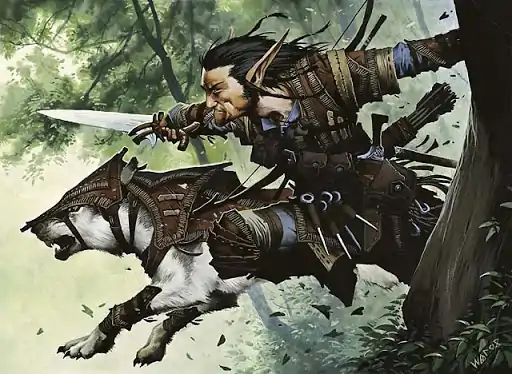Circle of Animals (5e Subclass)
Druids of the Circle of the Beast create deep and meaningful connection to the beasts of the wilds, and seek to protect them whenever possible. Druids of the circle may decide to live permanently in the wilds amongst the animals, in order to protect and learn about them. Choosing this circle allows druids to obtain an animal companion to follow them on their adventures. The animal companions of druids are often trusted to hunt and gather for themselves, and are still considered wild and untrained toward anyone other than their druidic partner.
 |
|---|
| These Druids share a deep compassion and respect for the Beasts of the Wild. |
Beast Companion
When you choose this circle at the 2nd level, you gain a beast companion that accompanies you on your adventures and is trained to fight alongside you. Choose a beast that is no larger than Medium and that has a challenge rating of 1/4 or lower. Add your proficiency bonus to the beast's AC, attack rolls, and damage rolls, as well as to any saving throws and skills it is proficient in. Its hit point maximum equals its normal maximum or four times your druid level, whichever is higher. It gains a number of hit dice equal to your druid level appropriate to its size. (d4 if Tiny, d6 if Small, and d8 if Medium). You can choose to spend these hit die on your companion to heal it during short rests the same way you'd use yours to heal yourself. It regains spent Hit Die after a long rest.
The beast obeys your commands as best as it can. It takes its turn on your initiative, though it doesn't take an action unless you command it to. On your turn, you can verbally command the beast where to move (no action required by you). You can use your action to verbally command it to take the Attack, Dash, Disengage, Dodge, or Help action. If you are incapacitated, your companion will do its best to defend you and itself, but otherwise takes no actions.
If the beast dies, you can obtain another one by spending 8 hours magically bonding with another beast that isn't hostile to you, either the same type of beast as before or a different one.
Animal Bonding
Also at the 2nd level, you may cast beast bond on your Beast Companion as a ritual. At the 3rd level, you may also cast beast sense on it as a ritual. To cast them as rituals on your companion, you do not need to have these spells prepared. Additionally, at the 5th level, you may expend a spell slot to cast revivify, but only if it is on your Beast Companion. You have this spell prepared, but it has no effect if it is not cast on a beast companion.
Beast Training
Starting at 6th level, on any of your turns when your beast companion doesn’t attack, you can use a bonus action to command the beast to take the Dash, Disengage, Dodge, or Help action on its turn. When your beast companion takes the Attack action, it can make two attacks, instead of one.
Primal Companion
At 10th level, your Beast Companion's attacks deal an extra amount of damage equal to your Wisdom modifier, and are considered magical for the purposes of overcoming resistance and immunity.
To Fight as One
At 14th level, you and your companion have a honed bond. When you cast a spell or attack a creature, your beast can use its reaction to attack a target of the spell or attack if it is within range.
Additionally, as long as you and your Companion can see each other, you both gain advantage on saving throws against being frightened or charmed.
Back to Main Page → 5e Homebrew → Character Options → Subclasses